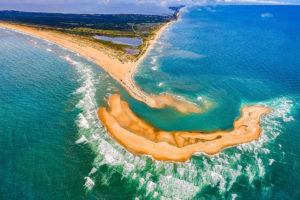There is always a summer story on Hatteras Island, a place known for romantic legends, swashbuckling tales and historical happenings that fill our history books and museums. But this season the summer story is still with us in the form of a new island off Cape Hatteras National Seashore’s iconic Cape Point.
The island is comma-shaped, almost a mile long and a football field across at its widest point. Named by a visiting youngster for its treasure trove of sea shells, Shelly Island started emerging from the waves off the tip of the Point sometime in April. By June friends, neighbors and visitors were making pilgrimages to the island on canoes, kayaks, paddleboards and surfboards. Hardier souls were wading, sometimes chest deep, through the water that separated the island from Cape Point. By August, wading was easier as the island was almost attached to the Point by a strand of sand.
The story found its way into the National Geographic magazine that described the island as appearing in a “dynamic stretch of sea where the cold, southbound Labrador Current churns and crashes into warmer Gulf Stream waters.” This is, the article continues, “a place of ‘swirling tides, hidden shoals and harsh winds known to sailors as the Graveyard of the Atlantic.”
The adventurous visitors and the national publicity gave rise to excited speculation as to the ownership of Shelly Island. Did this new piece of territory belong to the National Park Service or to Dare County? Who was responsible for any upkeep, maintenance or research to be conducted on the island? Stanley Riggs, a retired geology professor and author who has studied the Outer Banks for decades, has his own ideas. “Nothing here becomes a fixture,” says Riggs, in the National Geographic article. His thoughts are echoed by Hatteras Island’s own expert, life-long resident and tour guide Danny Couch. “Everything here can change overnight,” says Couch, who recalls seeing similar formations over the years, just not of such a scale.
Meanwhile, Shelly Island continues to amaze and astound. In addition to the myriad sea shells that cover the island, an unexploded World War II training device was discovered in its sand. It was recovered by a Navy ordinance disposal unit. A week later, according to the Charlotte Observer newspaper, a real bomb washed up on the tip of Hatteras Island about 13 miles away from Shelly Island. The Navy took care of that one, too, and exploded it.
So will Shelly Island be with us next summer to entertain and intrigue us again? Or will it disappear with the next storm? We’ll leave the last word to Mark Dowdle, Deputy Superintendent of Cape Hatteras Seashore, who suggests that everything on Hatteras Island, including the new little island, will continue to change. “It always has. It most likely always will.”

Are you sure that Shelly Island is not a sunken ship coming to the surface? Love the history of the Graveyard of the Atlantic. Hopefully will get to enjoy the shells in April